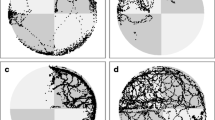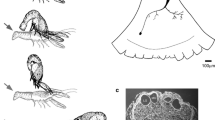Abstract
Fish escape from approaching threats via a stereotyped escape behavior. This behavior, and the underlying neural circuit organized around the Mauthner cell command neurons, have both been extensively investigated experimentally, mainly in two laboratory model organisms, the goldfish and the zebrafish. However, fish biodiversity is enormous, a number of variants of the basal escape behavior exist. In marine gobies (a family of small benthic fishes) which share burrows with alpheid shrimp, the escape behavior has likely been partially modified into a tactile communication system which allow the fish to communicate the approach of a predatory fish to the shrimp. In this communication system, the goby responds to intermediate-strength threats with a brief tail-flick which the shrimp senses with its antennae.
We investigated the shrimp goby escape and communication system with computational models. We asked how the circuitry of the basal escape behavior could be modified to produce behavior akin to the shrimp-goby communication system. In a simple model, we found that mutual inhibitions between Mauthner cells can be tuned to produce an oscillatory response to intermediate strength inputs, albeit only in a narrow parameter range.
Using a more detailed model, we found that two modifications of the fish locomotor system transform it into a model reproducing the shrimp goby behavior. These modifications are: 1. modifying the central pattern generator which drives swimming such that it is quiescent when receiving no inputs; 2. introducing a direct sensory input to this central pattern generator, bypassing the Mauthner cells.





Similar content being viewed by others
References
Chakraborty, M., & Jarvis, E. D. (2015). Brain evolution by brain pathway duplication. Philosophical Transactions of the Royal Society B: Biological Sciences, 370(1684), 20150056.
Eaton, R. C., Bombardieri, R. A., & Meyer, D. L. (1977). The Mauthner-initiated startle response in teleost fish. Journal of Experimental Biology, 66(1), 65–81.
Eaton, R. C., Lavender, W. A., & Wieland, C. M. (1981). Identification of Mauthern-initiated response patterns in goldfish: evidence for simultaneous cinématography and electrophysiology. Journal of Comparative Physiology, 144, 521–531.
Eaton, R. C., Lee, R. K. K., & Foreman, M. B. (2001). The Mauthner cell and other identified neurons of the brainstem escape network of fish, 63, 467–485.
Ermentrout, B. (2002). Simulating, analyzing, and animating dynamical systems: a guide to XPPAUT for researchers and students, (Vol. 14). Siam.
Ermentrout, G. B., & Terman, D. H. (2010). Mathematical foundations of neuroscience (Vol. 35). Springer Science & Business Media.
Hale, M. E., Katz, H. R., Peek, M. Y., & Fremont, R. T. (2016). Neural circuits that drive startle behavior, with a focus on the Mauthner cells and spiral fiber neurons of fishes. Journal of neurogenetics, 30(2), 89–100.
Holland, L. Z., & Short, S. (2008). Gene duplication, co-option and recruitment during the origin of the vertebrate brain from the invertebrate chordate brain. Brain, behavior and evolution, 72(2), 91–105.
Karplus, I. (1981). Goby-shrimp partner specificity. II. The behavioural mechanisms regulating partner specificity. Journal of Experimental Marine Biology and Ecology, 51(1), 21–35.
Karplus, I. (1979). The tactile communication between Cryptocentrus steinitzi (Pisces, Gobiidae) and Alpheus purpurilenticularis (Crustacea, Alpheidae). Zeitschrift für Tierpsychologie, 49(2), 173–196.
Karplus, I., Szlep, R., & M., Tsurnamal. (1981). Goby-shrimp partner specificity. I. Distribution in the northern Red Sea and partner specificity. Journal of Experimental Marine Biology and Ecology, 51(1), 1–19.
Karplus, I., & Thompson, A. (2011). The partnership between gobiid fishes and burrowing alpheid shrimps. The Biology of Gobies, 559–607.
Liu, K. S., Gray, M., Otto, S. J., Fetcho, J. R., & Beattie, C. E. (2003). Mutations in deadly seven/notch1a reveal developmental plasticity in the escape response circuit. Journal of Neuroscience, 23(22), 8159–8166.
Lyons, P. (2012). The evolution of mutualism between alpheid shrimp and gobiid fishes: a balance between benefits and costs (Doctoral dissertation, The Graduate School, Stony Brook University: Stony Brook, NY.).
Mäki-Marttunen, T., & Medan, V. (2014). A computational model on the goldfish Mauthner cell, BMC Neuroscience, 15(Suppl 1) 97.
Medan, V., & Preuss, T. (2014). The Mauthner-cell circuit of fish as a model system for startle plasticity. Journal of Physiology-Paris, 108(2–3), 129–140.
Miller, T. H., Clements, K., Ahn, S., Park, C., Ji, E. H., & Issa, F. A. (2017). Social status-dependent shift in neural circuit activation affects decision making. Journal of Neuroscience, 37(8), 2137–2148.
Park, C., Clements, K. N., Issa, F. A., & Ahn, S. (2018). Effects of social experience on the habituation rate of zebrafish startle escape response: empirical and computational analyses. Frontiers in neural circuits, 12, 7.
Preston, J. L. (1978). Communication systems and social interactions in a goby-shrimp symbiosis. Animal Behaviour, 26, 791–802.
Stiefel, K. M., & Reyes, R. B. (2018). The marine goby–alpheid shrimp symbiosis does not correlate with larger fish eye size. bioRxiv, 329094.
Turesson, H., Satta, A., & Domenici, P. (2009). Preparing for escape: anti-predator posture and fast-start performance in gobies. Journal of Experimental Biology, 212(18), 2925–2933.
Zeng, Y., & Jaafar, Z. (2012). Visual acuity of the goby-associated shrimp, Alpheus rapax Fabricius, 1798 (Decapoda, Alpheidae). Crustaceana, 85(12–13), 1487–1497.
Zottoli, S. J., & Faber, D. S. (2000). Review: the mauthner cell: what has it taught us? The Neuroscientist, 6(1), 26–38.
Acknowledgments
We would like to thank Ms. Lala Grace Calle, Ms. Dana Manogan, Drs. Nadia Palomar-Abesamis and Dr. Patrick Cabaitan for helpful discussion of the manuscript and the anonymous reviewers for helpful feedback on the first version. We would also like to thank Sungwoo Ahn for the Mauthner cell code for the complex model. G.B.E. would like to thank the National Science Foundation.
Author information
Authors and Affiliations
Contributions
K.M.S. conceived the idea to the study. J.A.L. and G.B.E. developed the model, wrote and ran the simulations. All authors wrote the manuscript.
Corresponding author
Ethics declarations
Conflict of interest
The authors declare no conflict of interest.
Additional information
Communicated by Action Editor: Catherine E Carr.
Rights and permissions
About this article
Cite this article
Landsittel, J.A., Ermentrout, G.B. & Stiefel, K.M. A computational model of the shrimp-goby escape and communication system. J Comput Neurosci 49, 395–405 (2021). https://doi.org/10.1007/s10827-021-00787-4
Received:
Revised:
Accepted:
Published:
Issue Date:
DOI: https://doi.org/10.1007/s10827-021-00787-4




